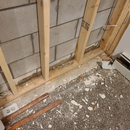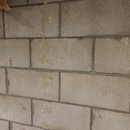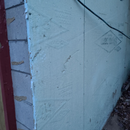Basement Moisture Solution
I’ve been renovating our basement due to the poor quality of the previous renovation. I already rebuilt the walkout wall thanks to the advice I got here and it’s working perfectly!
Unfortunately, now I’m on to the part that’s buried and I’m running into wet sill plates (they didn’t use treated, I’m remedying that already) and some moist mortar between the blocks. I’ve attached some pictures to illustrate what I’ve found.
My question since it’s very minor seeping is will I be alright placing a foam capillary break under the new treated sill plate and 2″ rigid foam against the masonry blocks? I’d be confident in this if I didn’t have rigid foam already on the exterior of the wall.
I’ve read on here that it’s ok to sandwich concrete with the foam, but is it ok to sandwich the cinder blocks or will that cause problems down the line? I’m in Northern WI also, so climate zone 7A.
I will be getting estimates on new draining this summer, but obviously would like to not have to leave my basement undone for months waiting for a contractor up here to get started. I’d also like to finish the basement before I go on orders for the summer so my wife doesn’t have to deal with half a house.
Thanks in advance!
GBA Detail Library
A collection of one thousand construction details organized by climate and house part












Replies
I do not see a problem with making the blocks into a foam sandwich. They may well get wet and moldy but will be undamaged and be outside of your are barrier.
How far below grade is the base of this wall?
Exterior drain installation gets very expensive as it gets deeper. Interior drains and a pump are generally the only affordable option.
Walta
+1 to Walta's post. However, exterior grading and drainage are still super important. The soil should slope away from the house for the first 10 feet or so, and the yard should be graded so that there isn't any standing water after it rains. Roof drains should discharge as far from the house as possible. In problem areas, a surface "gutter" can be made using roofing membrane draped into a trench that is pitched to drain, then the top is filled with washed gravel. There is more to doing this all properly but that's the overview.